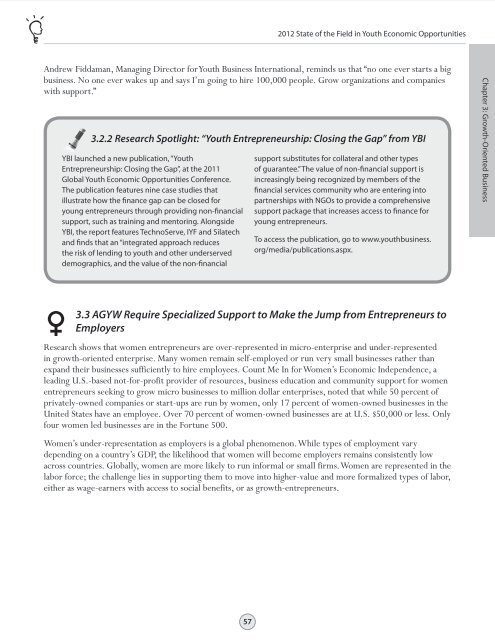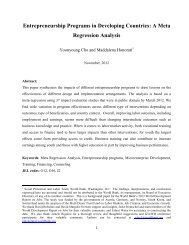STATE OF THE FIELD IN YOUTH ECONOMIC OPPORTUNITIES
STATE OF THE FIELD IN YOUTH ECONOMIC OPPORTUNITIES
STATE OF THE FIELD IN YOUTH ECONOMIC OPPORTUNITIES
You also want an ePaper? Increase the reach of your titles
YUMPU automatically turns print PDFs into web optimized ePapers that Google loves.
Table of Contents<br />
Chapter 1 Chapter 2 Chapter 3 Chapter 4 Chapter 5 Chapter 6 Chapter 7 Chapter 8<br />
Chapter 9<br />
Chapter 10 Chapter 11 Chapter 12 Chapter 13 Chapter 14 Chapter 15 Annexes<br />
2012 State of the Field in Youth Economic Opportunities<br />
Andrew Fiddaman, Managing Director for Youth Business International, reminds us that “no one ever starts a big<br />
business. No one ever wakes up and says I’m going to hire 100,000 people. Grow organizations and companies<br />
with support.”<br />
3.2.2 Research Spotlight: “Youth Entrepreneurship: Closing the Gap” from YBI<br />
YBI launched a new publication, “Youth<br />
Entrepreneurship: Closing the Gap”, at the 2011<br />
Global Youth Economic Opportunities Conference.<br />
The publication features nine case studies that<br />
illustrate how the finance gap can be closed for<br />
young entrepreneurs through providing non-financial<br />
support, such as training and mentoring. Alongside<br />
YBI, the report features TechnoServe, IYF and Silatech<br />
and finds that an “integrated approach reduces<br />
the risk of lending to youth and other underserved<br />
demographics, and the value of the non-financial<br />
support substitutes for collateral and other types<br />
of guarantee.” The value of non-financial support is<br />
increasingly being recognized by members of the<br />
financial services community who are entering into<br />
partnerships with NGOs to provide a comprehensive<br />
support package that increases access to finance for<br />
young entrepreneurs.<br />
To access the publication, go to www.youthbusiness.<br />
org/media/publications.aspx.<br />
Chapter 3: Growth-Oriented Business<br />
3.3 AGYW Require Specialized Support to Make the Jump from Entrepreneurs to<br />
Employers<br />
Research shows that women entrepreneurs are over-represented in micro-enterprise and under-represented<br />
in growth-oriented enterprise. Many women remain self-employed or run very small businesses rather than<br />
expand their businesses sufficiently to hire employees. Count Me In for Women’s Economic Independence, a<br />
leading U.S.-based not-for-profit provider of resources, business education and community support for women<br />
entrepreneurs seeking to grow micro businesses to million dollar enterprises, noted that while 50 percent of<br />
privately-owned companies or start-ups are run by women, only 17 percent of women-owned businesses in the<br />
United States have an employee. Over 70 percent of women-owned businesses are at U.S. $50,000 or less. Only<br />
four women led businesses are in the Fortune 500.<br />
Women’s under-representation as employers is a global phenomenon. While types of employment vary<br />
depending on a country’s GDP, the likelihood that women will become employers remains consistently low<br />
across countries. Globally, women are more likely to run informal or small firms. Women are represented in the<br />
labor force; the challenge lies in supporting them to move into higher-value and more formalized types of labor,<br />
either as wage-earners with access to social benefits, or as growth-entrepreneurs.<br />
57

















